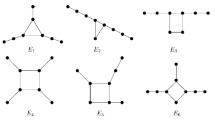Abstract
The traceability of some of the smaller polyhexes is examined. (A graph is said to be traceable or to have a Hamiltonian path if it has a path visiting every vertex just once.) Most polyhexes are traceable, and an attempt is made to develop some practical guidelines for finding those that are not. A subgraph consisting of the branching vertices of a polyhex, and of any edges which join pairs of such vertices, is a useful tool for this purpose. The “principal resonance structures” of such a graph suggest ways of finding simpler spannng subgraphs of the polyhex that will often make its traceability, or lack of it, more obvious.
Similar content being viewed by others
References
N.L. Biggs, E.K. Lloyd and R.J. Wilson,Graph Theory 1736–1936 (Clarendon Press, Oxford, 1976).
F. Harary and C.St.J.A. Nash-Williams, Can. Math. Bull. 8 (1965)701.
V. Chvátal, in:New Directions in the Theory of Graphs, ed. F. Harary (Academic Press, New York, 1973), p. 65.
C. Berge,Graphs and Hypergraphs (North-Holland, Amsterdam, 1973), Ch. 10.
V. Chvátal, Discr. Math. 5 (1973)215.
V. Chvátal, Math. Progr. 5 (1973)23.
F. Harary and R.B. Mallion, Nanta Mathematica 7 (1974)96.
R.B. Mallion, Chem. Phys. Lett. 36 (1975)170.
R.B. Mallion, Proc. Roy. Soc. London A341 (1975)429.
J.A. Bondy and U.S.R. Murry,Graph Theory and Applications (Elsevier, New York, and MacMillan, London, 1976).
A.G. Thomason, in:Advances in Graph Theory, ed. B. Bolobas (North-Holland, Amsterdam, 1978), p. 259.
J.C. Bermond, in:Selected Topics in Graph Theory, ed. L.W. Beineke and R.W. Wilson (Academic Press, New York, 1978), p. 127.
H.N.V. Temperley, in:Applications of Graph Theory, ed. R.J. Wilson and L.W. Beineke (Academic Press, London, 1979), Ch. 6.
H.N.V. Temperley,Graph Theory and Applications (Ellis Horwood, Chichester, 1981).
R.A. Brudidi and R.F. Shawry, J. Graph Theory 5 (1981)307.
R. Halin, J. Graph Theory 7 (1983)437.
W.W. Wong and C.K. Wong, J. Graph Theory 8 (1984)155.
H.J. Veldman, J. Graph Theory 10 (1986)23.
K. Devlin,Mathematics: The New Golden Age (Penguin Books, London, 1988).
R.B. Mallion, in personal correspondence with the author (12th April 1989), recalling conversations among R.B. Mallion, R.J. Wilson and F. Harary in Oxford, Englandcirca 1970–74, remarks “... I think we all felt that the “Hamiltonian problem” was not soluble — any apparent “conditions” found being essentially just a re-statement of what being Hamiltonian entails. ...”.
E.C. Kirby, in:Graph Theory and Topology in Chemistry, ed. R.B. King and D.H. Rouvray; Studies in Physical and Theoretical Chemistry 51(1987)529.
R.B. Mallion, in personal correspondence with the author (12th April 1989): The calculation requires the identification of a spanning tree. If the parent graph is untraceable (not path-Hamiltonian), then only the Gayoso-Boucekkine unitary transformation [23] can be used, but if it is path-Hamiltonian, then the McWeeny transformation [24,25] is also available.
J. Gayoso and A. Boucekkine, CR Acad. Sci. (Paris) C272 (1971)184.
R. McWeeny, Mol. Phys. 1 (1958)311.
C.W. Haigh and R.B. Mallion, in:Progress in NMR Spectroscopy, Vol. 13, ed. J.W. Emsley, J. Feeney and L.H. Sutcliffe (Pergamon, Oxford, 1979), pp. 303–344.
J.A.N.F. Gomes, Croat. Chem. Acta 53 (1980)561.
J.A.N.F. Gomes, Theor. Chim. Acta 59 (1981)333.
J.A.N.F. Domes and R.B. Mallion, Revista Port. Química 21 (1979)82.
R.C. Read, in:Applications of Graph Theory, ed. R.J. Wilson and L.W. Reineke (Academic Press, London, 1979), Ch. 13.
I. Gutman, R.B. Mallion and J.W. Essam, Mol. Phys. 50 (1983)859.
B. O'Leary and R.B. Maliion, in:Graph Theory and Topology in Chemistry, ed. R.B. King and D.H. Rouvray; Studies in Physical and Theoretical Chemistry 51(1987)544.
D.M. Cvetković and I. Gutman, Publications de l'Institut Mathématique 29 (1981)49.
I. Gutman, Croat. Chem. Acta 56 (1983)365.
J.V. Knop, W.R. Müller, K. Szymanski and N. Trinajstić,Computer Generation of Certain Classes of Molecules (SKTH/Kemija u industriji, Zagreb, 1985).
He Wenjie and He Wenchen, Theor. Chim. Acta, in press; personal preprint kindly supplied by Professor He Wenchen.
The characteristic graph or dualist graph [37,38] is notjust a graph because as defined it contains geometric information; some workers therefore prefer to call it simply the dualist. There are analogous considerations here with the proposed “branching graph”. When used for polyhex reconstruction, it must conform to the geometry of a hexagon lattice. However, the first procedure here, in which the principal resonance structures of the branching graph are examined, does deal with purely graph-theoretical properties. It seems legitimate therefore to name the entity as a graph, but one must remember that for some applications it is subject to geometrical constraints.
A.T. Balaban and F. Harary, Tetrahedron 24 (1968)2505.
A.T. Balaban, Pure Appl, Chem. 54 (1982)1075, and references therein.
W.C. Herndon, Tetrahedron 29 (1973)3.
B. Džanova-Jerman-Blalžič and N. Trinajstić, Computers and Chem. 6 (1982)121.
J.R. Dias, J. Macromol. Sci.-Chem. A22 (1985)335.
J.R. Dias, Nouveau J. de Chimie 9 (1985)125.
S.J. Cyvin and I. Gutman, Z. Naturforsch. 41A (1986)1079.
J.R. Dias, Chem. Phys. Lett. 22 (1985)35.
E.C. Kirby, Computers and Chem. 9 (1985)155.
I. Gutman and S.J. Cyvin, J. Mol. Strum (THEOCHEM) 138 (1986)325.
J.R. Dias, J. Mol. Struct. 149 (1987)213.
S.J. Cyvin and I. Gutman, J. Mol. Struct. (THEOCHEM) 164 (1988)183.
K. Balasubramanian, Theor. Chim. Acta 74 (1988)111.
J.V. Knop, W.R. Müller, K. Szymanski and N. Trinajstić, J. Comput. Chem. 7 (1986)547.
T.G. Schmalz, G.E. Hite and D.J. Klein, J. Phys. A17 (1984)445.
D.J. Klein, private communication (20th June 1989).
R.J. Wilson,Introduction to Graph Theory (Academic Press, New York, 1972, and Longman Group, Harlow, England, 1975).
R.J. Wilson and L.W. Beineke, in:Applications of Graph Theory (Academic Press, London, 1979), Ch. 1.
Author information
Authors and Affiliations
Rights and permissions
About this article
Cite this article
Kirby, E.C. Hamiltonian paths in polyhexes: The use of branching subgraphs to assist diagnosis of graph traceability. J Math Chem 4, 31–46 (1990). https://doi.org/10.1007/BF01170002
Issue Date:
DOI: https://doi.org/10.1007/BF01170002




